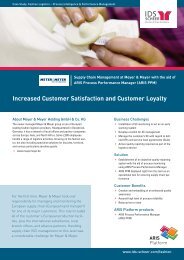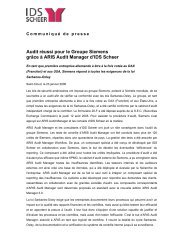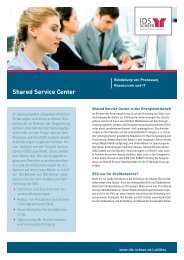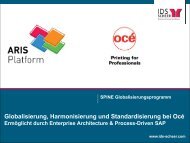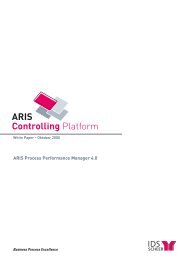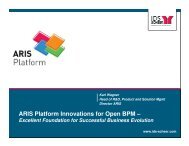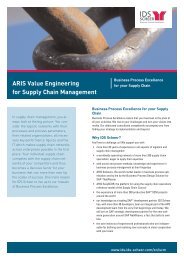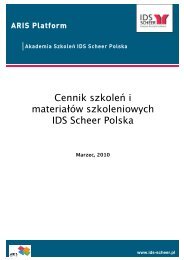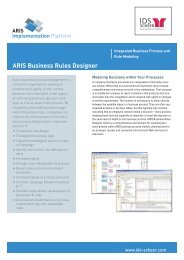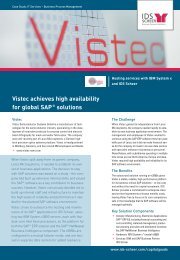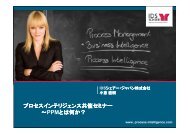From Business Process Design to Enterprise ... - IDS Scheer AG
From Business Process Design to Enterprise ... - IDS Scheer AG
From Business Process Design to Enterprise ... - IDS Scheer AG
Create successful ePaper yourself
Turn your PDF publications into a flip-book with our unique Google optimized e-Paper software.
ARIS Expert Paper<br />
March 2007<br />
ARIS<br />
Platform<br />
Expert<br />
Paper<br />
<strong>From</strong> <strong>Business</strong> <strong>Process</strong> <strong>Design</strong> <strong>to</strong><br />
<strong>Enterprise</strong> Architecture<br />
www.ids-scheer.com
Find out more at:<br />
www.aris.com/ea<br />
Don’t lose sight of<br />
the big picture!<br />
Complex systems always require good building<br />
plans. So take you organization’s business<br />
processes and use them as the foundation<br />
for you IT environment.<br />
ARIS Solution for <strong>Enterprise</strong> Architecture<br />
Management allows you <strong>to</strong> describe your IT<br />
environment using leading frameworks and<br />
integrate it in<strong>to</strong> your process management system.<br />
<strong>From</strong> IT portfolio management <strong>to</strong><br />
business processes and IT<br />
architecture matrix, all elements<br />
are combined in the central<br />
ARIS Reposi<strong>to</strong>ry. This enables<br />
you <strong>to</strong> attain a transparent<br />
corporate IT landscape.
<strong>From</strong> <strong>Business</strong> <strong>Process</strong> <strong>Design</strong> <strong>to</strong> <strong>Enterprise</strong> Architecture<br />
Corporate growth typically goes hand in hand with an increasingly<br />
complex IT environment. Mergers add <strong>to</strong> the problem by creating<br />
redundancy, while shrinking system lifecycles necessitate more<br />
flexible IT architecture management. It becomes increasingly difficult<br />
<strong>to</strong> identify business-critical systems, and cost-cutting targets<br />
prove elusive. Aligning IT structures with an organization’s objectives<br />
and business processes is the only way <strong>to</strong> achieve sustained<br />
improvements and a significant reduction in the cost of developing,<br />
maintaining, and upgrading IT systems. This paper shows how ARIS<br />
<strong>Enterprise</strong> Architecture Solution allows IT infrastructures <strong>to</strong> be<br />
aligned with corporate processes and enables long-term IT architecture<br />
management.<br />
Find out how:<br />
• ARIS <strong>Enterprise</strong> Archi tecture Solution can be used <strong>to</strong> align IT<br />
systems with the needs of corporate processes and<br />
• long-term IT architecture management can be imple mented.<br />
The business processes in <strong>to</strong>day’s organizations are based on highly<br />
sophisticated enterprise-wide IT systems. Enter prise architectures (EA)<br />
have emerged as the key <strong>to</strong>ol for documenting, analyzing, and managing<br />
these complex structures, in turn forming part of an architecture framework<br />
that describes the information re quired for a complete architecture.<br />
ARIS <strong>Enterprise</strong> Architecture Solution enables companies <strong>to</strong> create,<br />
update, and optimize enterprise architectures based on architecture standards<br />
such as DoDAF, Zachman, TOGAF, TEAF, FEAF, Archimate, and IT City<br />
Planning. The ARIS house acts as the basis for the different EA frameworks<br />
(fig. 1).<br />
Fig. 1: Support for multiple enterprise architecture frameworks<br />
ARIS Expert Paper<br />
About the authors:<br />
Dirk Maurer<br />
is the <strong>IDS</strong> <strong>Scheer</strong> <strong>AG</strong> development<br />
manager responsible for the ARIS<br />
<strong>Design</strong> Platform products<br />
E-mail:<br />
arisproductmarketing@ids-scheer.com<br />
Patrick Büch<br />
is an <strong>IDS</strong> <strong>Scheer</strong> project manager<br />
responsible for enter prise architecture<br />
and designing/developing ARIS<br />
<strong>Enterprise</strong> Architecture Solution.<br />
E-mail:<br />
arisproductmarketing@ids-scheer.com<br />
3
ARIS Expert Paper<br />
The fact that the framework-specific methods are linked <strong>to</strong> the various ARIS method views, and <strong>to</strong> the central ARIS<br />
reposi<strong>to</strong>ry, gives companies a holistic view of their entire organization.<br />
Pivotal <strong>to</strong> the ARIS method is an object-oriented approach for reusing architecture artifacts across different views.<br />
This makes it possible <strong>to</strong> recognize how corporate strategy, business processes, and IT architectures interact and <strong>to</strong><br />
build the necessary bridges.<br />
<strong>Business</strong><br />
Strategy<br />
& Requirements<br />
An enterprise architecture compromises four different architecture descriptions, as shown in figure 2:<br />
The business architecture defines business strategies and describes organizational structures and business processes.<br />
The application architecture describes the services and application systems that support the business processes.<br />
The information architecture describes the business objects and data that are exchanged between process participants<br />
and applications.<br />
The lowest level is the infra structure architecture, which is used <strong>to</strong> describe the physical landscape—the hardware<br />
and networks that support the application systems.<br />
This type of description highlights the impact of business process changes on the associated IT systems. System<br />
redundancy can be detected and new IT requirements identified. Similarly, the business processes affected by system<br />
shutdowns and infrastructure changes can be easily identified.<br />
Creating a standardized IT environment is impossible without first standardizing business processes. For this reason,<br />
the methods and integrational <strong>to</strong>ols used for IT architecture management must create a structure that is fully synchronized<br />
with process management.<br />
The ARIS Value Engineering for <strong>Enterprise</strong> Archi tec ture (AVE for Enter prise Architecture) method provides models and<br />
procedures based on ARIS Platform <strong>to</strong>ols that enable corporate IT architectures <strong>to</strong> be aligned with business needs.<br />
The objective is an awareness that system architectures are a means <strong>to</strong> an end, and not an end in themselves –<br />
because businesses face an ongoing need <strong>to</strong> adapt <strong>to</strong> changing circumstances and priorities.<br />
4<br />
<strong>Business</strong><br />
Architecture<br />
Application<br />
Architecture<br />
<strong>Business</strong> <strong>Process</strong>es,<br />
Workflows, Transactions<br />
and Collaboration<br />
Systems, Services,<br />
Functional Use Cases<br />
Infrastructure Architecture<br />
Fig. 2: <strong>From</strong> business processes <strong>to</strong> IT systems<br />
Information<br />
Architecture<br />
Data, <strong>Business</strong> Objects,<br />
Exchange Formats,<br />
Security and Privacy<br />
Hardware,Server,OS,Network<br />
Program<br />
& Project<br />
Management<br />
Portfolio<br />
Analysis
1. <strong>Business</strong> Architecture<br />
The key function of information technology is <strong>to</strong> sup port and optimize corporate processes. Accor dingly, IT strategy<br />
should reflect corporate strategy. IT architectures need <strong>to</strong> be documented, analyzed, and optimized from a business<br />
process perspective. Based<br />
on this insight, the ARIS<br />
method begins by recording<br />
the corresponding corporate<br />
processes in ARIS<br />
Busi ness Archi tect, supported<br />
by a special process<br />
model. During the design<br />
phase, users can define<br />
core elements of an architecture,<br />
such as organizational<br />
units, application systems,<br />
data, and IT system<br />
re quirements.<br />
Figure 3 shows a sample<br />
business process, documenting<br />
and highlighting the<br />
relationship between activities,<br />
data, participants, and<br />
systems.<br />
Fig. 3: <strong>Business</strong> architecture<br />
Fig. 4: Organizational map<br />
ARIS Expert Paper<br />
Figure 4 is an organizational “map” that shows the<br />
relationship between corporate locations, business<br />
pro cesses, and the underlying IT systems.<br />
Documenting and analyzing existing structures in<br />
this way is the first step <strong>to</strong> creating an optimized<br />
blueprint for future development. A reporting mechanism<br />
allows data <strong>to</strong> be aggregated for further<br />
analysis and <strong>to</strong> generate overviews, i.e. the map<br />
can be leveraged <strong>to</strong> create a roadmap for evolution<br />
of the IT environment.<br />
The degree of standardization is shown using colorcoding,<br />
controlled by a system attribute. Red indicates<br />
the status “non-standard.”<br />
Divergent IT structures across different departments<br />
and divisions are often a legacy of mergers<br />
and acquisitions. In such situations, the failure <strong>to</strong><br />
harmonize systems im pacts expected synergies<br />
and can also trigger higher costs due <strong>to</strong> duplicated<br />
development effort.<br />
5
ARIS Expert Paper<br />
Detailed analysis re quires knowledge of the exact nature of the pro cesses in the different parts of the organization<br />
and recognition of why they differ. The importance of this work lies in the fact that harmonizing processes is key <strong>to</strong><br />
harmonizing systems.<br />
IS functions (information system func tions) form the link between business processes and IT systems (fig. 5) by de -<br />
scribing a system in terms of functionality.<br />
This allows them <strong>to</strong> be reused in business processes<br />
<strong>to</strong> document the IT system functionality required<br />
by a specific business function (fig. 6). An impact<br />
analysis then provides an easy way of establishing<br />
the extent <strong>to</strong> which an IT system is embedded in<br />
business processes and whether some IT systems<br />
duplicate the same functionality.<br />
6<br />
<strong>Process</strong> <strong>Process</strong> description description System System functions functions and and and services services<br />
services IT IT IT landscape<br />
landscape<br />
IT system description<br />
IT IT system system description<br />
description<br />
IT IT standards<br />
standards<br />
Standard<br />
Standard Technology<br />
Technology<br />
& Solutions<br />
& Solutions<br />
Infrastructure<br />
Development<br />
Fig. 5: IS functions as the link between processes and IT systems<br />
Fig. 6: Use of IS functions in business processes
2. Application Architecture<br />
The application archi tecture is described using<br />
multiple views, which are presented in the following<br />
sections.<br />
2.1 IT system environment<br />
The model below (fig. 7) groups the applications in<strong>to</strong><br />
several thematic blocks. This is where the new<br />
“object-in-object” functionality of ARIS 7.0 comes<br />
in, allowing exact mapping of applications <strong>to</strong> individual<br />
thematic blocks and the splitting of applications<br />
in<strong>to</strong> several subsystems across a number of<br />
levels.<br />
Fig. 8: Architecture <strong>to</strong>olkit<br />
Each of these database objects contains infor -<br />
mation that includes the manufacturer, version, and<br />
links <strong>to</strong> the relevant manuals.<br />
A database object also contains details of the standardization<br />
status: “standard,” “non-standard,” etc.<br />
The aim of standardization is <strong>to</strong> cut maintenance<br />
costs, but reducing the diversity of deployed technologies<br />
can also deliver savings on staff training<br />
and the procurement of hardware and software.<br />
ARIS Expert Paper<br />
Fig. 7: IT system environment<br />
2.2 Architecture <strong>to</strong>olkit<br />
An architecture <strong>to</strong>olkit is used <strong>to</strong> manage all the<br />
technologies and systems deployed in an organization.<br />
It allows an IT architect <strong>to</strong> define standards as<br />
a means of harmonizing future development of the<br />
IT environment. Figure 8 shows an example of an<br />
architecture <strong>to</strong>olkit. Additional models can be used<br />
<strong>to</strong> display information in greater detail – like the<br />
model for database system management in figure 9.<br />
Fig. 9: Database systems<br />
7
ARIS Expert Paper<br />
2.3 System description<br />
Access diagrams are used <strong>to</strong> describe systems at<br />
type level (fig. 10). The type level (often also called<br />
the “logical view”) contains information about the<br />
underlying operating system, programming language,<br />
database, hardware type, organization<br />
responsible, and person responsible for the application.<br />
Parts of this system description can be<br />
imported from a configuration ma na ge ment database<br />
(CMDB). Keeping this information up <strong>to</strong> date is<br />
the task of the person responsible for the application.<br />
Fig. 11: Navigation and analysis functions<br />
The interfaces between a system and other systems<br />
are shown in figure 12. Information about the data<br />
exchanged, pro<strong>to</strong>cols used, etc., can also be s<strong>to</strong>red<br />
here.<br />
Here again, this view enables the impact of system<br />
and interface changes <strong>to</strong> be analyzed.<br />
8<br />
Fig. 10: System description<br />
Navigation and analysis functions (fig. 11) are used<br />
for such purposes as identifying the systems that<br />
feature specific technologies. This makes it possible<br />
<strong>to</strong> analyze the impact of a change of technology,<br />
provider, or version, and <strong>to</strong> inform/involve the relevant<br />
persons.<br />
Fig. 12: Interface diagram
3. Information Architecture<br />
The following diagram (ERM, fig. 13) shows the data<br />
overview and a more detailed description of the<br />
data. This data can be reused in process descriptions<br />
covering input/output data relating <strong>to</strong> specific<br />
activities, the data flow, and data exchange<br />
between process participants. The data objects<br />
also serve as the basis for describing data<br />
exchange between applications, and can be s<strong>to</strong>red<br />
with the interfaces.<br />
Fig. 14: Application system instances<br />
The following diagram (fig. 14) shows various different<br />
instances of application systems. Network diagrams<br />
(fig. 15) allow the relationship between networks,<br />
routers, switches, and hardware (servers,<br />
printers, etc.) <strong>to</strong> be shown. The icons used here can<br />
be modified <strong>to</strong> suit specific user needs, as can<br />
those in the other diagrams.<br />
Fig. 13: Data model<br />
ARIS Expert Paper<br />
4. Infrastructure Architecture<br />
In addition <strong>to</strong> the description at type level, systems<br />
are also described at the physical level (instances).<br />
Instances can have information associated with<br />
them, such as hardware used, network segments,<br />
system support responsibility, ports, and IP<br />
addresses.<br />
Fig. 15: Network diagram<br />
9
ARIS Expert Paper<br />
5. Summary<br />
By creating a seamless interconnect between IT and process architecture in a single reposi<strong>to</strong>ry, from strategy<br />
through <strong>to</strong> infrastructure level, ARIS <strong>Enterprise</strong> Architecture Solution makes it possible for the first time <strong>to</strong> fully align<br />
IT systems with business needs.<br />
Benefits include being able <strong>to</strong> identify which critical business processes at which locations are affected and will<br />
therefore need <strong>to</strong> be part of the migration project when replacing an IT system. Planners and IT managers can navigate<br />
the entire enterprise architecture, following object relationships, and take informed decisions based on a holistic<br />
view of the company and a shared methodology.<br />
Users can compare the IT standards and target architectures defined in the reposi<strong>to</strong>ry with the actual situation and<br />
create a roadmap for future development. Importantly, ARIS <strong>Business</strong> Architect facilitates organization-wide enterprise<br />
architecture management by supporting distributed teams. The resulting architecture information can be documented<br />
in the intranet with the help of ARIS <strong>Business</strong> Publisher, a dynamic publishing <strong>to</strong>ol, in a way that meets the<br />
needs of specific groups. In addition <strong>to</strong> designing enterprise architectures, companies can use this functionality <strong>to</strong> set<br />
up process and IT portals.<br />
Bringing <strong>to</strong>gether business process design and IT architectures allows coordinated management of these two areas,<br />
enabling the kind of integrative approach that is particularly important for successful enterprise architecture management,<br />
given the interdependency of processes and IT structures.<br />
10
ARIS Expert Paper<br />
ARIS<br />
Platform<br />
Expert<br />
Paper<br />
Headquarters<br />
Germany<br />
<strong>IDS</strong> <strong>Scheer</strong> <strong>AG</strong><br />
Altenkesseler Straße 17<br />
66115 Saarbruecken<br />
Phone: +49 (0)681-210-0<br />
Fax: +49 (0)681-210-1000<br />
E-mail: info@ids-scheer.com<br />
“ARIS”, “<strong>IDS</strong>” and “Y” symbol are trademarks or registered trademarks of <strong>IDS</strong> <strong>Scheer</strong> <strong>AG</strong> in Germany and in many other countries worldwide. All other trademarks are the property of their respective owners.<br />
Inven<strong>to</strong>ry Number EA 0607-E-EP Copyright <strong>IDS</strong> <strong>Scheer</strong> <strong>AG</strong> 06.2007<br />
www.ids-scheer.com



